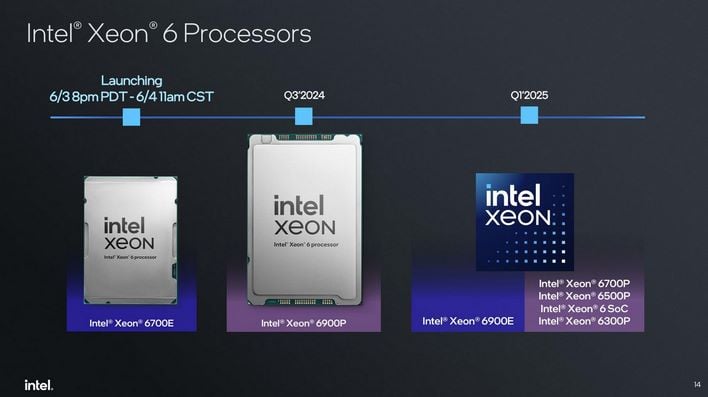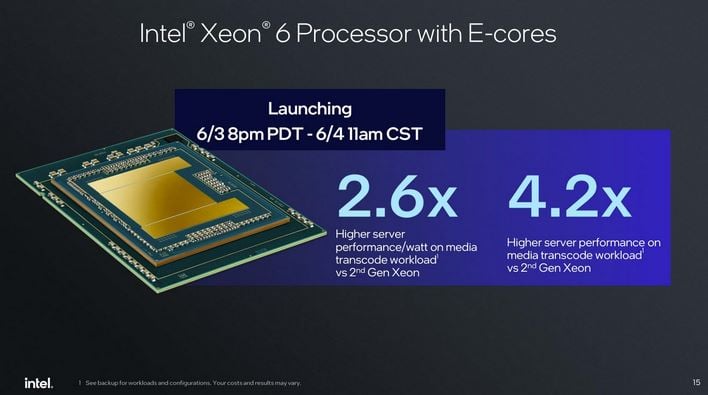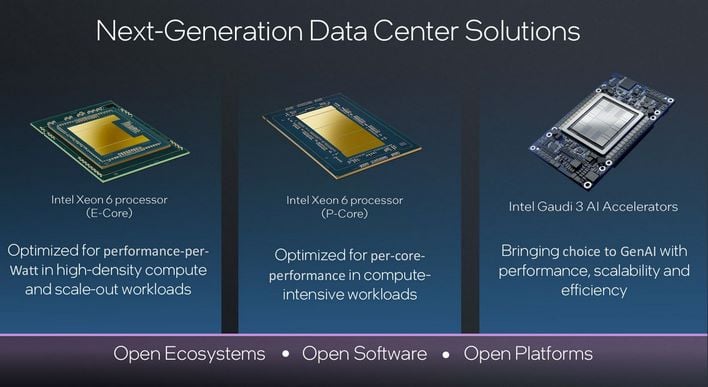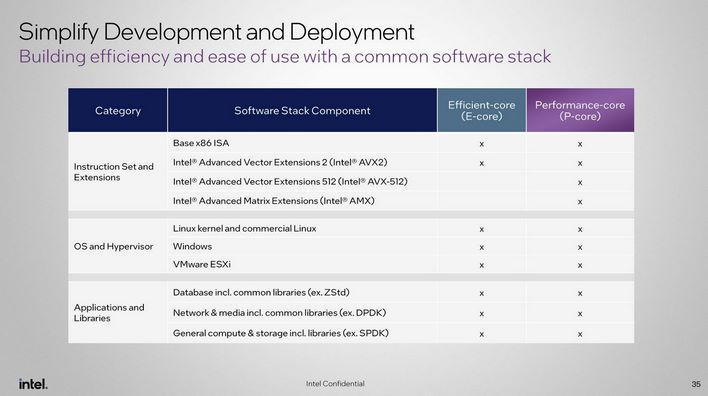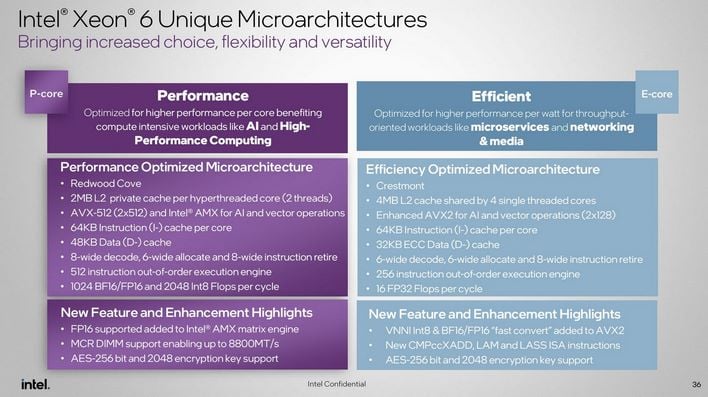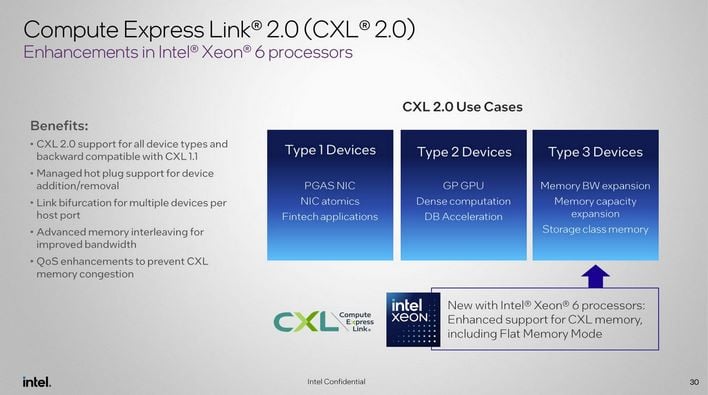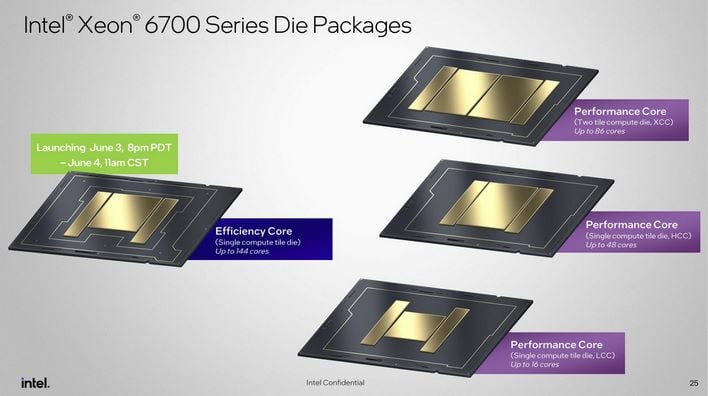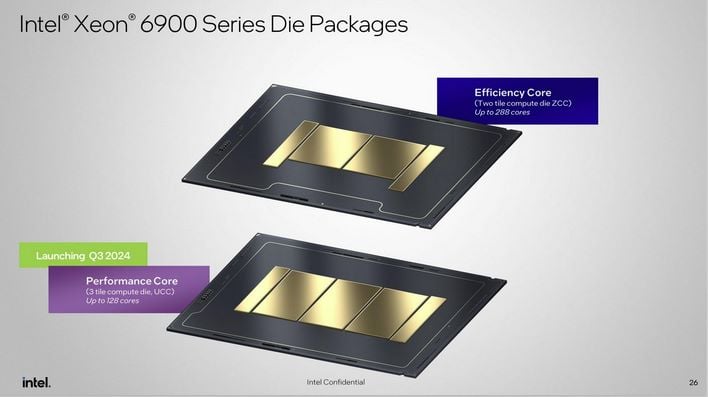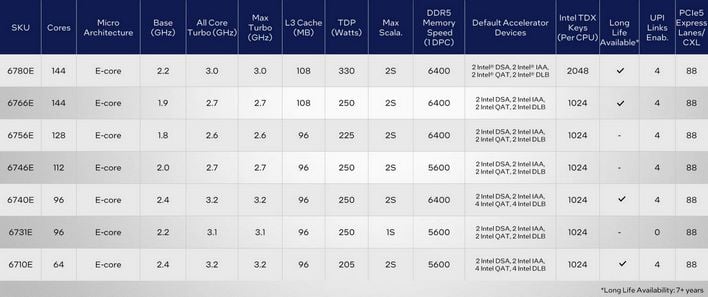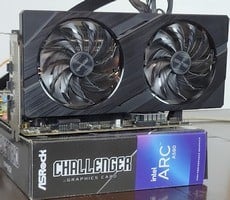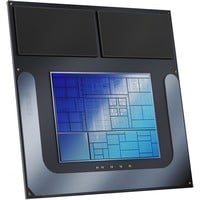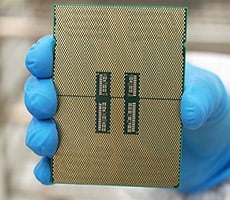Intel Xeon 6 Preview: 144 Core Sierra Forest Debuts With 288 To Come
| Intel Xeon 6 Series Processors Intel is launching the first wave of next-generation Xeon 6 6700E-series processors today, based on Sierra Forest, featuring up to 144 E-cores per socket.
|
|||

|

|
||
The benefits of Intel’s advanced packing technologies, modern tile-based designs, and CEO Pet Gelsinger’s relentless approach to product releases is on full display today with the launch of the Xeon 6 family of server processors. Officially announced today, the Xeon 6 6700E series – previously codenamed Sierra Forest – will be the first series of Xeon 6 processors to arrive in-market, followed shortly by the 6900P series next quarter, and some additional models in both the 6700 and 6900 series targeting various use cases early next year.
In less than 1.5 years, we’ve evaluated 4th and 5th Gen Xeon scalable processors, and actually have a Xeon 6 6700E-based server on-prem running through its paces right now. As soon as we have some fresh performance data, we’ll be sharing it, so keep an eye on the site or sign up for our daily newsletter to be alerted when that happens.
Introducing The Intel Xeon 6
Launching three new families of server processors is less than 1.5 years is an impressive feat that is even more impressive so when you consider Intel is using a somewhat different strategy with the Xeon 6 series, which actually consists of multiple different architectures. And we’re not just talking about a mix of E and P-cores here. The first wave of Xeon 6 6700E series processors to arrive are based on Sierra Forest, and are comprised solely of high-efficiency, low-power E-cores. The Xeon 6 6900P series coming next quarter is based on Granite Rapids and is comprised solely of high-performance P-cores. Xeon 6 6700P, 6900E, 6500P, 6300P and Xeon 6 SoC series processors are also in bound, with a mix of configurations. The E obviously denotes E-cores, and the P, P-cores. So, the Xeon 6 series feature not only two different architectures, but two different microarchitectures as well.Before we continue, we should mention Gaudi 3, which is also a part of Intel’s next-gen data center products. As a companion to the new Xeon 6 series, Intel also has its Gaudi 3 AI Accelerator on tap, which is more akin to a GPU and is positioned against some of NVIDIA and AMD’s offerings. We have the skinny on Gaudi 3 available here if you’d like to learn more – we’ll be focused on the Xeon 6 in this piece.
Intel is taking this multi-architecture approach with the Xeon 6 series in an attempt to better address ever evolving market needs that are rapidly shifting in this age of AI. The Xeon 6 E-core based processors are optimized for high-density, scale out workloads, while the P-core based Xeon 6es are optimized for flat-out per-core performance, for compute intensive workloads. Though they use disparate architectures, however, both series of processors use a common platform foundation and software stack. There will be two sockets at play with the Xeon 6 though and depending on which core technology is being employed, different features and accelerators available. More on that shortly.
There will be some overlap with the Xeon 6 6700 and 6900 series processors, but Intel in targeting them for very different applications and workload requirements, in an effort to provide more optimized, tailored solutions for its customers. As such, it is critically important to understand how the Efficient E-cores and Performance P-cores differ and what features and capabilities may be present (or absent) in a particular Xeon 6 series of processors.
The E-cores used on the Xeon 6 series are based on Intel’s Crestmont microarchitecture. They feature 4MB of shared L2 cache, per 4-core cluster. The cores are single-threaded only (no HT here), and feature 64KB on Instruction cache and 32KB of Data cache. They are 6-wide decode and allocate engines, with 8-wide instruction retire. Crestmont also features a 256 instruction out-of-order execution engine and it can handle 16 FP32 Flops per cycle. The cores also feature AES-256 bit and 2048 encryption key support, and have a handful of additional instructions over previous-gen parts, along with support for enhanced AVX2 for AI and vector operations.
The P-cores used on the Xeon 6 series are based on the Redwood Cove microarchitecture, similar to what’s used in Meteor Lake. Each core has its own, 2MB of L2 cache, along with 64KB on Instruction cache and 48KB of Data cache. The P-cores are wider 8-wide decode and 6-way allocate engines, with 8-wide instruction retire. Redwood Cove also features a deeper 512 instruction out-of-order execution engine and support for additional data types. The cores are capable of 1024 BF16/FP16 and 2048 Int8 Flops per cycle. Like Redwood Cove also features AES-256 bit and 2048 encryption key support, in addition to AVX-512 and Intel AMX. P-core based Xeon 6 processors also support MCR DIMMs, or Multiplexer Combined Ranks Dual In-line Memory Module. MCR DIMMs feature multiple DRAMs bonded to a PCB, where two ranks can operate simultaneously, for higher effective transfer rates of up to 8800MT/s.
Xeon 6 series processors also feature support for CXL 2.0 – previous-gen 5th generation Xeon processors supported CXL 1.1. CXL 2.0 is compatible with all of the same devices, and features managed hot plug support, link bifurcation for multiple devices per port, and enhanced memory interleaving and QoS for improved effective bandwidth.
Speaking of bandwidth, Xeon 6 6700 series processors support up to 8 memory channels, at up to 6400MT/s with DDR5 memory or up to 8000MT/s with using the aforementioned MCR DIMMs on P-core based models. 6700 series Xeon 6 processors also support up to 88 PCIe 5 lanes, and 4 UPI 2.0 links at 24GT/s. 6700E series E-core based processors will support 1 or 2 socket configurations, while P-core based 6700P series processors can scale up to 8 sockets. The max TDP is 350W per CPU in the 6700 series, and they will feature up to 144 E-cores or 86 P-cores.
The 6900 series cranks almost everything higher. 6900 series Xeon 6 processors will only support 1 or 2 socket configurations, but they feature 12 memory channels at up to 6400MT/s with DDR5 memory or up to 8800MT/s with MCR DIMMs, 96 PCIe 5 lanes, and 6 UPI 2.0 links. Power per CPU increases up to 500W and core counts top out at a whopping 288 E-cores or 128 P-cores.
How Does Intel Build Xeon 6 Processors?
Intel is able to offer such a wide assortment of configuration and features due to the inherent modularity of its advanced packaging technologies – including EMIB, module-die fabric, and tile-based, multi-die architecture.Xeon 6 processors are built using modular compute and IO dies, linked using a high-speed fabric that traverses all die in the package. The compute die – whether featuring E-cores or P-cores – are manufactured using the Intel 3 process, while the IO die is manufactured on Intel 7. As their names suggest, the compute die is packed with all of the cores, and the IO die features the UPI, PCIe and CXL connectivity, in addition to the Intel Accelerator engines.
How Intel mixes and matches the compute and IO die, what determines series of Xeon 6 processor is built. The Xeon 6 6700E series is comprised of a pair of IO die with a single compute die, featuring up to 144 E-cores. The rest of the 6700 series is also outfitted with a pair of IO die, and either one, or two compute dies with P-cores.
The upcoming Xeon 6 6900 series also feature two IO die, with either two or three compute die. The two compute die configuration is what will be called the 6900E and packs up to a whopping 288 E-cores into a single socket. The three compute die configuration will be the 6900P, and features up to 128 P-cores.
Like 4th and 5th Gen Xeon Processors, the new Xeon 6 series also feature an array of accelerators to benefit particular workloads (when enabled), to compliment the CPU cores. The full assortment of accelerators Intel has offered include:
- Intel Advanced Matrix Extensions (Intel AMX) – P-core models
- Intel Advanced Vector Extensions 512 (Intel AVX-512) – P-core models
- Intel Data Streaming Accelerator (Intel DSA)
- Intel In-Memory Analytics Accelerator (Intel IAA)
- Intel Dynamic Load Balancer (Intel DLB)
- Intel Advanced Vector Extensions (Intel AVX) for vRAN
- Intel QuickAssist Technology (Intel QAT)
- Intel Crypto Acceleration
We are unclear on whether or not Intel Advanced Vector Extensions (Intel AVX) for vRAN or the Intel Crypto Accelerator will be offered in some Xeon 6 models, but have asked the question and are hoping for some clarity. The IO die is home to the remaining accelarators, and AMX and AVX-512 are offered on P-core based models.
The Xeon 6 6700E Series Arrives First - Here Are The SKUs
As mentioned, the first wave of Xeon 6 processors due to arrive ar in the Xeon 6 6700E family, and feature E-cores exclusively. The full SKU stack for the 6700E family includes 7 models...Core counts on the intitial Xeon 6 6700E offerings range from 64 (6710E) on up to 144 for the top-end 6780E. Frequencies obviously vary depending on model, and scale as high as 3.2GHz. The TDP (up to 330W) and L3 cache configurations (up to 108MB) very as well, as do memory speeds (from 5600MT/s to 6400MT/s), though all of the parts offer 88 PCI Express lanes. The defaul accelerators are outlined in the table too. All but the 6731E are 1 or 2 socket compatible, and feature 4 UPI links.
This first wave of Xeon 6 processors is fairly tame relative to previous releases when dozens of processors debuts simultaneously. Rest assured, as the other series of Xeon 6 processors launch in the coming quarters, the SKU stack will expand considerably.
And what about performance? Let's see what Intel is saying...

